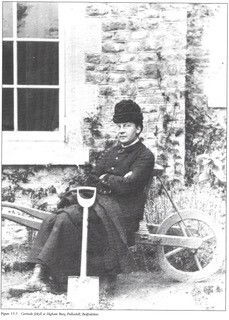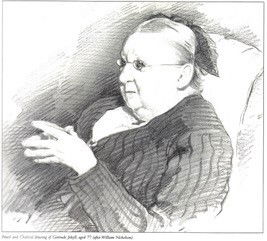Who was Gertrude Jekyll?
Gertrude Jekyll was born in London in 1843. She came from a line of notable figures, including a solicitor-general to the Prince of Wales and a master of the rolls. She was educated by her parents and governesses at home, where she met many famous figures of the time. She and her sister had their own garden, and Gertrude was also a talented artist. She enrolled at the National School of Art in South Kensington in 1861 and exhibited at the Royal Academy and the Society of Female Artists from 1865. The range of her abilities increased, and she gained recognition for the quality of her work. Her talents included embroidery, painting, quilting, interior design, advice on furnishings and working as an art blacksmith.
Jekyll was one half of one of the most influential and historical partnerships of the Arts and Crafts movement, thanks to her association with the English architect Edwin Lutyens.
Life and Work
19th Century
From the 1860s onwards, Jekyll had visited several countries around the Mediterranean and collected plants. These were to become characteristic features of her garden designs. She selected and bred more than thirty herbaceous annuals, dwarf shrubs, perennials and biennials, several of which won prizes at the Royal Horticultural Society. In 1897 she was awarded the Victoria medal of honour of the Royal Horticultural Society. She contributed to the journal The Garden from 1881.
After the death of her father in 1876, Gertrude and her mother moved to Munstead House, a new house commissioned from John James Stevenson. Gertrude laid out the gardens, which included an alpine garden, kitchen garden, parterre, orchard, azalea grove and pergola. Gertrude's own house, Munstead Wood, was built close by in 1895, where Gertrude also laid out the garden. The unconventional garden layout and massing of colours attracted attention from distinguished gardeners and botanists, and Jekyll's reputation as a garden designer was soon established.
20th Century
Over the next 35 years she undertook more than 400 commissions in Britain, Europe and America. In 1908 her ideas were set out in her book Colour in the Flower Garden. At around the same time she established a plant nursery at Munstead Wood, which she used to supply plants to her clients and was run by Jekyll until 1932. Her clients were many and varied, ranging from local authorities, hospitals, publishers, charities, friends and private individuals. She became known to a large audience through articles in the Daily Mail, Daily Express, The Garden and Gardening Illustrated.
Most of Jekyll's designs were commissioned directly by her clients, but some projects were carried out in collaboration with architects, notably Sir Edwin Lutyens. Lutyens designed Jekyll's house at Munstead Wood, and was a frequent visitor. They had a dynamic working relationship which produced some remarkable results, for example at Hestercombe in Somerset.
Jekyll published 14 books and over a thousand articles, so her ideas are well-documented although many of her gardens have been lost. Survivors include Hestercombe, Lindisfarne Castle and her own garden at Munstead. She was painted by William Nicholson in 1920, as were her Balmoral boots which she had worn, patched and repaired since 1883. She was awarded the Royal Horticultural Society gold Veitch medal in 1929. She died at Munstead Wood in December 1932.
Sources
Tooley, Michael, ‘Jekyll, Gertrude (1843-1932)', Oxford Dictionary of National Biography (Oxford: Oxford University Press, Sept 2004; online edn, Oct 2006) http://www.oxforddnb.com/view/... [ accessed 25 June 2009]
Further reading
The Garden History Society, 'Note on the Jekyll Papers' (deposited by the Society, November, 1984).
Photographs provided by and show with permission from https://gertrudejekyll.co.uk/ the official website of the Gertrude Jekyll estate.


Associated Places
- Amport Park
- Amport Park
- Arundel Castle
- Ashby St Ledgers
- Ashwell Bury
- Barrington Court
- Barton St Mary
- Berkeley Castle
- Bestbeech St Mary
- Bishops Barns
- Blagdon Hall
- Boveridge House School
- Broughton Castle
- Busbridge Lakes
- Castle Drogo
- Chart Cottage, Seal Chart
- Chenies Place
- Chesterton Road, Number 80
- Cheyne Walk, Number 100, Chelsea
- Clifford Manor
- Digswell Place
- Dyke Nook Lodge
- Field House, Clent
- Fishers Gate
- Folly Farm
- Frant Court
- Fulmer Court
- Gatley Park
- Gledstone Hall
- Great Maytham Hall
- Greywalls, East Lothian
- Hartland Abbey
- Hascombe Court
- Hatchlands
- Heathcote
- Hestercombe House and Gardens
- Hill Hall
- Hollington Park
- Homewood, Knebworth
- Hursley Park
- King Edward VII Hospital
- Knebworth
- Lainston House
- Legh Manor
- Lindisfarne Castle
- Little Halings
- Little Thakeham
- Marsh Court
- Mells Manor House
- Mells Park
- Mells Park, formal gardens
- Mount Stewart
- Munstead Wood
- New Place
- Oaklee
- Orchards
- Penheale Manor
- Phillips Memorial Cloister
- Plumpton Place
- Priory Gardens, Orpington
- Putteridge Bury
- Pyrford Court
- Rignalls
- Seymour Court
- St Fagans Court
- Stonepits Manor, Seal
- Stratton Park
- Sutton Place, Woking
- Temple Dinsley
- The Deanery Garden, Sonning
- The Hoo, Willingdon
- The Manor House, Upton Grey
- The North Canonry
- The Salutation
- Townhill Park
- Tunworth Down House
- Tylney Hall
- Valewood Farm
- Vann
- Vann, Water Garden
- West Dean
- Westbrook
- Winchester College Garden of Remembrance
- Woodcutt House
- Yew Tree Hall